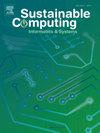面向精准农业的物联网光传感器网络
IF 5.7
3区 计算机科学
Q1 COMPUTER SCIENCE, HARDWARE & ARCHITECTURE
引用次数: 0
摘要
精准农业是一种现代农业方法,采用最先进的技术和数据驱动的决策来提高产量。在这种情况下,通过整合物联网设备和光学传感器,有很大的潜力来改善农业经营。传感器网络和基于机器学习的跟踪设备提供的准确数据提取和分析需求很大。本研究旨在促进智慧农业,降低农业风险。昆虫和其他病原体会引起植物病害,如果不及时处理,可能会降低产量。因此,在本研究中,我们提供了一种新颖的人工鱼群优化Naïve贝叶斯技术来监测土壤质量和预防影响棉花叶片的疾病。目前的研究使用带有光学传感器的物联网设备来跟踪对作物生长和健康至关重要的几个指标。这些传感器记录有关温度、湿度、光照强度、叶绿素含量和其他重要环境变量的信息。然后,采集到的数据被无线传输到一个中央服务器,在那里,建议的方法被用来处理和分析数据。在确定感染后,通过Android应用程序。土壤参数,如湿度,温度和湿度可以通过Android应用程序显示容器中的化学水平。电源和化学喷洒系统可以通过Android应用程序打开或关闭继电器来管理。实验结果表明,与传统的疾病检测方法相比,建议的策略表现更好。本文章由计算机程序翻译,如有差异,请以英文原文为准。
IoT-based optical sensor network for precision agriculture
Precision agriculture is a modern agricultural method that employs state-of-the-art technology and data-driven decision-making to increase yields. In this context, there is much potential to improve agricultural operations by integrating Internet of Things devices and optical sensors. The accurate data extraction and analysis provided by sensor networks and Machine Learning based tracking devices are in high demand. This study aims to promote intelligent farming while lowering agricultural risks. Insects and other pathogens can cause plant illnesses, which may decrease yield output if not handled promptly. Therefore, in this research, we provide a novel Artificial Swarm Fish Optimized Naïve Bayes technique to monitor the soil's quality and guard against diseases that affect cotton leaves. The present study uses Internet of Things devices with optical sensors to track several metrics vital to crop development and health. These sensors record information about temperature, humidity, light intensity, chlorophyll content, and other important environmental variables. The acquired data is then wirelessly communicated to a centralized server, where the suggested approach is used to process and analyze the data. After identifying the infection, through an Android app. Soil parameter like humidity, temperature, and moisture may be presented with the chemical level in a container using the Android app. The power source and chemical sprinkler system may be managed by turning the relay on or off using an Android app. The experimental results show that the suggested strategy performs better when compared to conventional methods of illness detection.
求助全文
通过发布文献求助,成功后即可免费获取论文全文。
去求助
来源期刊

Sustainable Computing-Informatics & Systems
COMPUTER SCIENCE, HARDWARE & ARCHITECTUREC-COMPUTER SCIENCE, INFORMATION SYSTEMS
CiteScore
10.70
自引率
4.40%
发文量
142
期刊介绍:
Sustainable computing is a rapidly expanding research area spanning the fields of computer science and engineering, electrical engineering as well as other engineering disciplines. The aim of Sustainable Computing: Informatics and Systems (SUSCOM) is to publish the myriad research findings related to energy-aware and thermal-aware management of computing resource. Equally important is a spectrum of related research issues such as applications of computing that can have ecological and societal impacts. SUSCOM publishes original and timely research papers and survey articles in current areas of power, energy, temperature, and environment related research areas of current importance to readers. SUSCOM has an editorial board comprising prominent researchers from around the world and selects competitively evaluated peer-reviewed papers.
 求助内容:
求助内容: 应助结果提醒方式:
应助结果提醒方式:


